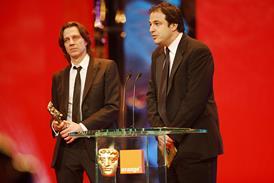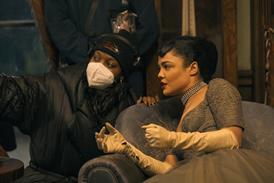Writer-director JC Chandor talks to Jeremy Kay about making his feature directorial debut with financial thriller Margin Call, one of the first films to sell in Sundance.
Myriad Pictures is handling international sales on JC Chandor’s Margin Call, which was one of the first films to sell at Sundance, finding its US home at Roadside Attractions and Lionsgate. The first-class ensemble of Kevin Spacey, Paul Bettany, Zachary Quinto, Stanley Tucci, Simon Baker, Demi Moore and Jeremy Irons made it one of the most compelling films at Sundance.
How did you wind up writing something like Margin Call?
I’d been a television and commercials and documentary director and producer for many years. I’d written a few other projects and after one of them fell apart a couple of days before principal photography it kind of sent me into the woods for a while and I was looking around to see if there as anything else I could do. I took about three years off and didn’t do anything. Then a partner and I renovated a commercial apartment in downtown Manhattan and sold it at a very fortuitous time and it gave me a new lease of life.
“In the fall of 2008 everything got really shaky and I thought about the story. It was a world I knew well because my father had worked for 40 years at Merrill Lynch, although not as a trader, and I knew who these characters were, so I didn’t have to do too much initial research. And frankly the bank that had leant us money for the commercial property really shouldn’t have done so either, which is related to how the whole crisis happened in the first place.
“I grew up in suburban London and New York where these kinds of people lived, so I knew the psyche a bit. I’d never written anything remotely topical like this before so I gave it a try and wrote it in four days. I gave it to two people. It was pretty rough and one of my producers Joe Jenckes set up a meeting with Zachary Quinto’s production company and they liked it.
How did an unknown filmmaker get such an extraordinary ensemble cast?
Casting was crucial on a little project like this. Zachary came on board, initially only as a producer because Star Trek hadn’t come out yet but they’d seen it and knew it was going to be big. So he was in this odd position where he knew what was going to happen but didn’t have this tremendous momentum yet. Shortly after that we attached Ben Kingsley, although he dropped out because of a scheduling conflict and we eventually got Jeremy Irons.
We kept on attaching people but even though the summer of 2009 wasn’t the easiest time to raise money we got this amazing cast of actors circling like Bettany and Tucci because frankly at that time there wasn’t a lot of work, especially in the independent world. This script gathered a lot of momentum at CAA and developed this kind of cult status. We closed Spacey’s deal at Cannes 2010 and by then we had a viable production plan and Myriad Pictures was selling international rights at Cannes.
How did the financing come together?
We had about four pieces in place, financing-wise. Michael Benaroya came in as the second to last piece and as the cast started to grow Michael started buying out the other elements because he became more bullish about saying the budget had to come up because of the cast we were assembling and we had to take care of this cast. The budget finally went from $2m to $3m with Benaroya as the sole equity investor.
When and where did you shoot?
We shot over 17 days in June and July 2010. We found an entire floor of a skyscraper which had been occupied by a hedge fund that moved out and left this perfect set for us. It was a 200-person with offices and boardrooms, so we just had all our dressing rooms and camera and costume departments etc set up on that floor. We probably had the same shooting time as a $5m or $6m film could have afforded because all we were doing was shooting. There were no trailers and my actors were with me the whole time and they had these offices as their dressing rooms. It came out in the film – the manic energy of these characters being locked into this space.
The film certainly treats the audience with respect. While many who saw Margin Call had no trouble keeping up with on-screen developments, some had difficulty understanding why traders were looking aghast at their computers in the early part of the film.
I didn’t write this for everyone. This wasn’t supposed to be a tentpole movie. There’s a fine line – viewers don’t know all of the words and while it makes you feel smart hearing it I took out some of the jargon from the original script. From conducting my interviews with people in finance I learned that there would be traders looking at computer screens but nobody wanted to say what they were looking at because the reality of what they were seeing was too terrible to articulate. You’d have rooms where people would be digesting the information in silence.
What’s next for JC Chandor?
I have a two-picture writing assignment at Appian Way on the Warner Bros lot and just turned in the first one, Portofino, which Leonardo DiCaprio is producing. I have a very actor-driven project that I will hopefully shot next summer or fall. It’s bigger than Margin Call and I’m coming to Los Angeles to cast it.




















No comments yet